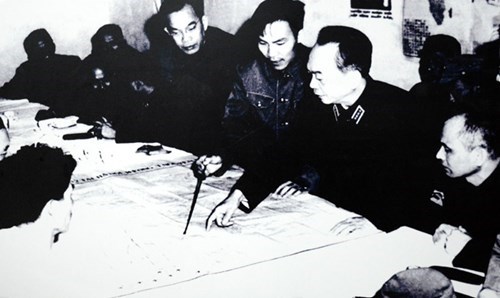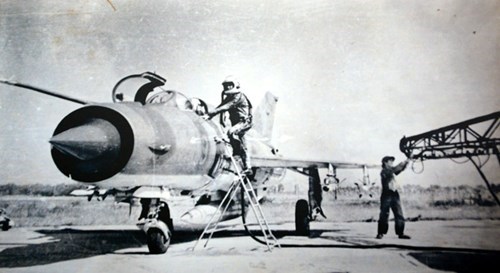President Ho Chi Minh’s forecast and strategic readiness
In late 1972, the Air Defense and Air Force of North Vietnam was tasked with three important missions of directly combating in the joint force at the Quang Tri front, defending traffic movement in Zone 4 front, and being ready to fight against the massive air raids over Hanoi and Hai Phong.
Accordingly, the Air Defense had to be stationed at various sites to meet the strategic demands. Only five missile regiments, six anti-air artillery regiments, and four air force regiments, including two Mig-21 regiments were available to protect Hanoi and Hai Phong. There were only four radar regiments in North Vietnam. Moreover, the militia’s air defense force in nine provinces was equipped with 1,316 anti-air guns of different types. Comparing weaponry and economic strengths, the U.S. outnumbered Vietnam and was sure to win. But it is not the fact. One of the important reasons that helped Vietnam to a victory in the campaign was careful preparation in both strategy and campaign.
    |
 |
| General Vo Nguyen Giap (2nd from right) ratified the plan of the Air Defense-Air Force of North Vietnam against the U.S. Air Force’s strategic B-52 air campaign. (File photo) |
At a conference to celebrate the 45th anniversary of the Victory of Hanoi–Dien Bien Phu in the Air, held in Hanoi recently, Lieutenant General Nguyen Xuan Mau, who was then Deputy-Political Commissar of the Air Defense and Air Force, recalled: “Right from 1962, Uncle Ho met comrade Phung The Tai, who was just promoted to be Commander of the Air Defense, and asked: “Do you know anything about B-52 planes?” And he went on: “If we know something, we cannot do anything now, but we should prepare immediately to be ready to deal with them...” “
On June 18, 1965, for the first time in the war’s history, the U.S. used B-52s to bombarded Ben Cat area, Northwest of Saigon. One month later, on July 19, 1965, President Ho Chi Minh visited the “pioneer” anti-air regiment and Company 1 of the “Tam Dao” anti-air regiment. He said at the visit: “Although the U.S. had many guns, lots of money, B-57, B-52, or whatever B it was, we were determined to fight. Those numbers of aircraft and forces, even more, we still fought against them and we were sure to win.”
On April 12, 1966, B-52s attacked Mu Gia Pass, Quang Binh province. Uncle Ho directed comrade Dang Tinh, Political Commissar Air Defense and Air Force: B-52s bombed the North, we had to find measure to bring them down. And he tasked that responsibility to the Air Defense and Air Force Service.
After that, on December 29, 1967, in a working meeting with Air Defense and Air Force Commander Phung The Tai, President Ho Chi Minh forecast: “Sooner or later, the U.S. would use B-52s to attack Hanoi and it would only accept defeat if it lost that fight. We had to anticipate this situation as soon as possible to have more time consider and prepare... In Vietnam, the U.S. was sure to be defeated but it would only accept the defeat in the air of the North Vietnam”.
On April 5, 1972, when the war situation in South Vietnam was becoming fiercer, the Central Military Commission (CMC) commanded the Air Defense and Air Force Services and Military Regions: “Be ready to combat if the U.S. use airpower, including strategic airpower, to attack the North again.” And in November 1972, the CMC stressed again: “The U.S. Imperialist can recklessly use B-52s to bomb Hanoi and Hai Phong.”
On November 24, 1972, Chief-of-the-General Staff of the Vietnam People’s Army Van Tien Dung and his deputies Tran Quy Hai, Vuong Thua Vu, Cao Van Khanh, and Phung The Tai approved and ratified the plan, prepared by the Air Defense and Air Force Service, to fight back B-52s to protect Hanoi and Hai Phong. This was an operational plan in which the Air Defense and Air Force were to play a key role.
After the plan was signed, the Chief-of-the-General Staff ordered: “All preparatory activities must be done before December 3, 1972”. He added: “Before the day Nixon took office, the U.S. could launch a strategic air attack against Hanoi and Hai Phong so that all comrades should understand the enemy thoroughly. We should not be surprised... and focused all of our capability to shoot down B-52s”.
In early December 1972, Party Secretary General Le Duan went to the Command Room of the Air Defense and Air Force to directly listen to the service’s Commander Le Van Tri presenting the plan to fight against B-52s. He stressed that to put pressure on us, sooner or later, the U.S. would use B-52s to attack Hanoi. Our people and soldiers, with the Air Defense and Air Force as the main force, must be resolute to foil this plot.
Therefore, strategically speaking, we are not surprised with the U.S. plot.
Learning to fight B-52s under bombardments
To stiffen determination and to prepare a plan to fight against B-52s, right from May 1966, the Air Defense and Air Force dispatched Missile Regiment 238 of Division 363, to move to Vinh Linh to fight and work out measures to deal with the B-52s. During one year of moving and fighting, two units of the regiment was tasked to ambush to attack B-52s. The regiment researched about B-52s under their bombardments by observing directly smoke tracks and bomb explosions to analyze flight formation and operational tactics of B-52s.
On March 15, 1967, B-52s appeared. The regiment fought but was not successful. Later one, the enemy discovered that there were missiles in Vinh Linh and sought to try to destroy these targets.
    |
 |
| An aircraft of Air Force Regiment 921 was prepared to protect the Hanoi's sky. (File photo) |
In January 1972, the Air Defense and Air Force continued to move four missile regiments to Zone 4, together with some Mig-21s, to share fire to Tri Thien Campaign and to find ways to fights against B-52s. During this time, one B-52 was shot down, but it crashed at some distance from the spot and the pilots and crew managed to escape. However, with experiences learnt on the battle field, the Air Defense and Air Force managed to prepare a plan to fight again B-52s.
Strategically, the North Vietnam was well prepared so that on December 18, 1972, when the U.S. started the air campaign in Hanoi, we were very active and not surprised. With war guidelines from the right people, we managed to build a broad people’s air defense posture, creating a strong power to defeat the enemy. In this force composition, it is necessary to mention the role of the forces of radar, fighter, surface-to-air missile, anti-air gun, and air defense of the militia.
(to be continued)
Translated by Nam Long